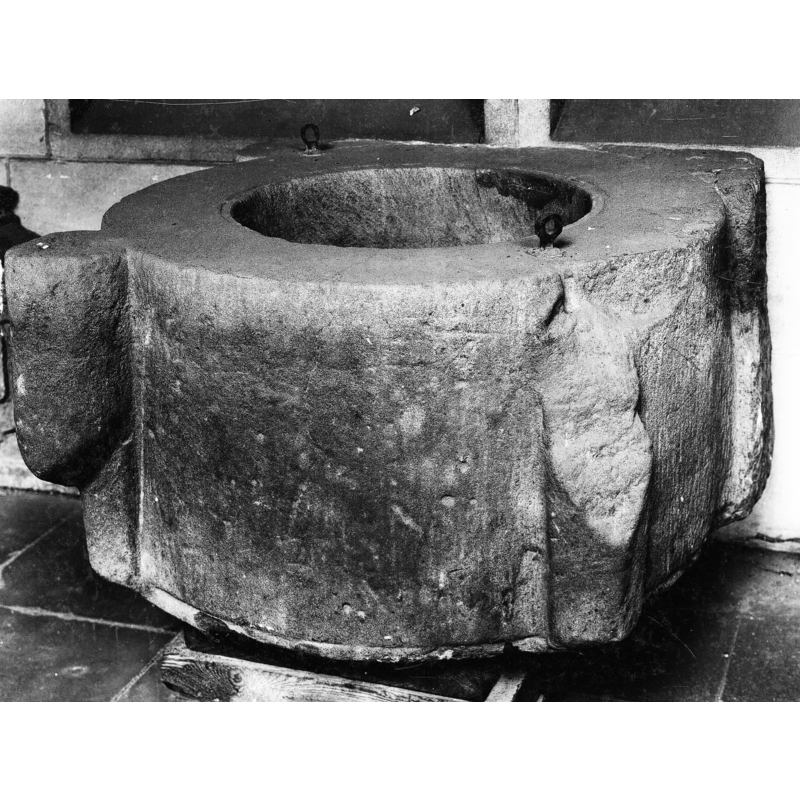Berbroek No. 1

Image copyright © KIK-IRPA, Brussels (Belgium), 2024
CC-BY-4.0
Results: 3 records
human figure - head
Scene Description: damaged and unfinished
Copyright Statement: Image copyright © KIK-IRPA, Brussels (Belgium), 2024
Image Source: digital image of a 1942 photograph [cliché B030101] in the Musées Royaux d'Art et d'Histoire [https://balat.kikirpa.be/object/11078365] [accessed 8 April 2024]
Copyright Instructions: CC-BY-4.0
view of basin
Scene Description: the damaged and unfinished basin shown here in a 1942 photograph taken in the Musées Royaux d'Art et d'Histoire, soon after its acquisition in 1941
Copyright Statement: Image copyright © KIK-IRPA, Brussels (Belgium), 2024
Image Source: digital image of a 1942 photograph [cliché B030101] in the Musées Royaux d'Art et d'Histoire [https://balat.kikirpa.be/object/11078365] [accessed 8 April 2024]
Copyright Instructions: CC-BY-4.0
INFORMATION
FontID: 25416BER
Object Type: Baptismal Font1 (basin only)
Museum and Inventory Number: Musées Royaux d'Art et d'Histoire / Kon. Musea voor Kunst en Geschiedenis [cf. FontNotes]
Church/Chapel: Parochiekerk Onze-Lieve-Vrouw-Geboorte, Berbroek
Church Patron Saints: The Nativity of St. Mary
Church Location: [address & coordinates for the church] Grotestraat 78-82, Berbroek, 3540 Herk-de-Stad, Belgium
Country Name: Belgium
Location: Limburg, Vlaanderen / Flandres
Directions to Site: Located off (N) the N2, in the municipality and 3 km E of Herk-de-Stad, 12 km W of Hasselt
Ecclesiastic Region: Bisdom Hasselt
Font Location in Church: [cf. FontNotes]
Date: n.d.
Century and Period: 13th - 14th century [basin only], Medieval [basin only]
Workshop/Group/Artisan: Ateliers de la Dyle
Credit and Acknowledgements: We are grateful to Pol Herman for bringing this object to our attention and for his help in documenting it
Font Notes:
Click to view
In Tollenaere (1957). Listed and illustrated in BALaT KIK-IRPA [https://balat.kikirpa.be/object/11078365] [accessed 8 April 2024] as the basin of a baptismal font made of sandstone ["grès ferrugineux de Diest"] by the Ateliers de la Dyle: "hauteur: 48 cm; diamètre: 88 cm"; the KIK-IRPA entry (ibid.) gives the date as "601 - 700" which must be a mistake; it further notes that it was originally from Berbroek but was acquired by the Musées Royaux d'Art et d'Histoire in 1941. [NB: although never finished, the basin top has two metal staples to accommodate a font cover]. The entry for Berbroek in Stedentips voor Trips [https://www.stedentipsvoortrips.nl/belgie/herkdestadbb.htm] [accessed 8 April 2024] mentions its Romanesque baptismal font in the Brussels museum ["De oude Romaanse doopvont is thans in de Kon. Musea voor Kunst en Geschiedenis te Brussel"].
A communication to BSI from Pol Herman (e-mail 13 December 2023) notes: "The church is first mentioned in 1308. It became a parish in 1309. The baptismal font of Berbroek is a special case and unique.
1.- It is not made of mosan limestone but of the local Diestian ferruginous sandstone. This would suggest that it has been manufactured by stone masons working in a local quarry. Or maybe it was made on site during construction works at the church.
2.- It was not finished. It looks like one of the four heads broke off during the manufacturing. As a result, no further effort was made to finish the work. It would be weird to supply (transport) such worthless object to the church building, this could support the hypothesis that it was made on the building site of the church?
3.- However, a basin was carved in it. The walls of the basin were left unusually thick. Maybe to avoid further damage ?
4.- Because it is unfinished, it is difficult to put a date on it. The general design would indicate a late Romanesque font not unlike the one at Gorsem. Probably first halve of 13th century.
5.- It is useful to study the working methods of the stone masons.
6.- Diestian ferruginous sandstone is not really suitable for fonts and for sculpting. It a building material, tends to be porous, and erodes easily.
It was at the Musées Royaux d’Art et d’Histoire in Brussels, but it seems that it has recently been returned to the church."
Pol Herman's e-mail includes Jen-Claude Ghislain's comments on this piece: "La cuve provenant de Berbroek, utilisée comme bac à charbon dans un débarras lors de son acquisition en 1941, est un cas isolé en grès diestien régional avec patine brunâtre. Si la filiation typologique à quatre têtes parfois brisées est romane, l’inachèvement sommaire de la pièce empêche d’évaluer une datation relative fondée. Le diamètre du bassin est inhabituellement réduit et le bord supérieur de la cuve très épais conserve des attaches métalliques tardives d’un couvercle qui atteste l’utilisation, mais où et quand ? Des cassures éventuelles en cours d’exécution pourraient expliquer son inachèvement, visible aux deux têtes dont le dégagement est inachevé."
Pol Herman's e-mail includes a reference to Tollenaere (1957) [cf. supra]
COORDINATES
Church Latitude & Longitude Decimal: 50.950572, 5.208261
Church Latitude & Longitude DMS: 50° 57′ 2.06″ N, 5° 12′ 29.74″ E
UTM: 31U 655109 5646650
MEDIUM AND MEASUREMENTS
Material: stone, sandstone (grès ferrugineux de Diest)
Font Shape: round
Basin Interior Shape: round
Basin Exterior Shape: round
Diameter (includes rim): 88 cm*
Basin Total Height: 48 cm*
Notes on Measurements: * KIK-IRPA
REFERENCES
KIK-IRPA, BALaT KIK-IRPA, 2024. Accessed: 2024-04-09 00:00:00. URL: https://balat.kikirpa.be/.
Tollenaere, Lisbeth, "La sculpture sur pierre dans l'ancien diocèse de Liége à l'époque romane", 4e Série, Fascicule II., Recueil de Travaux d'Histoire et de Philologie, 1957
![the damaged and unfinished basin shown here mounted on a modern base [cf. FontNotes]](/static-50478a99ec6f36a15d6234548c59f63da52304e5/others/permission_not_available.jpg)